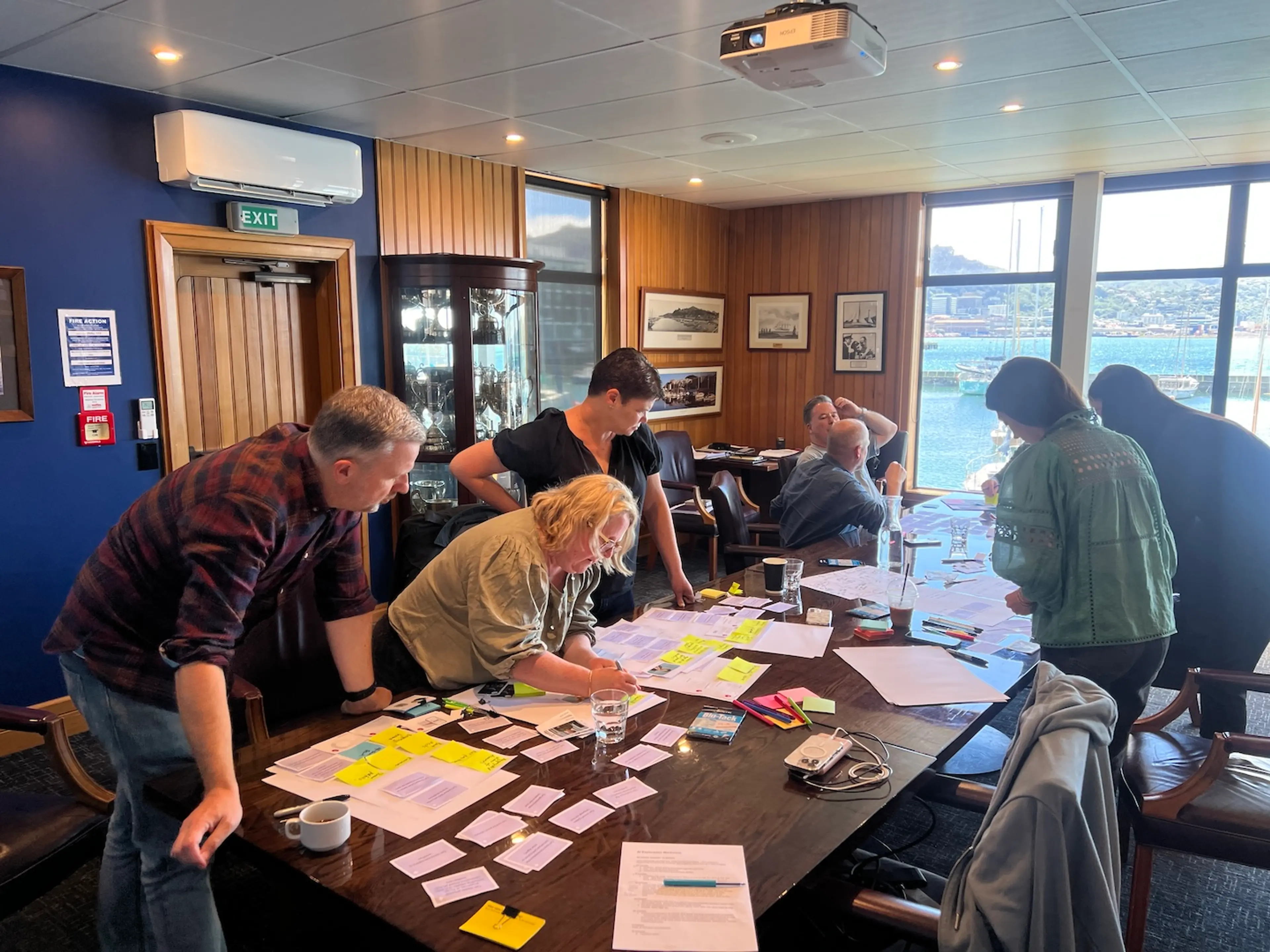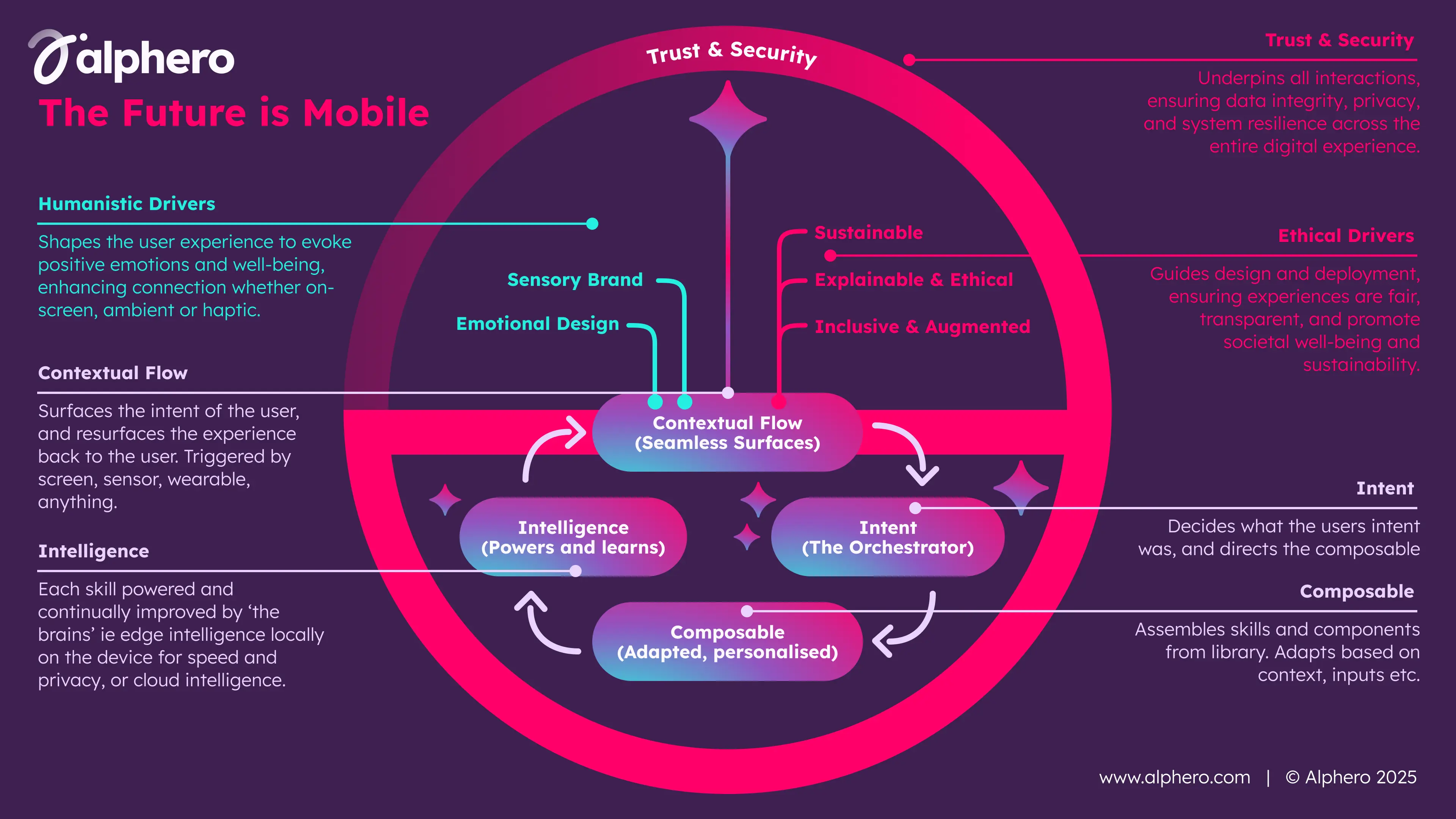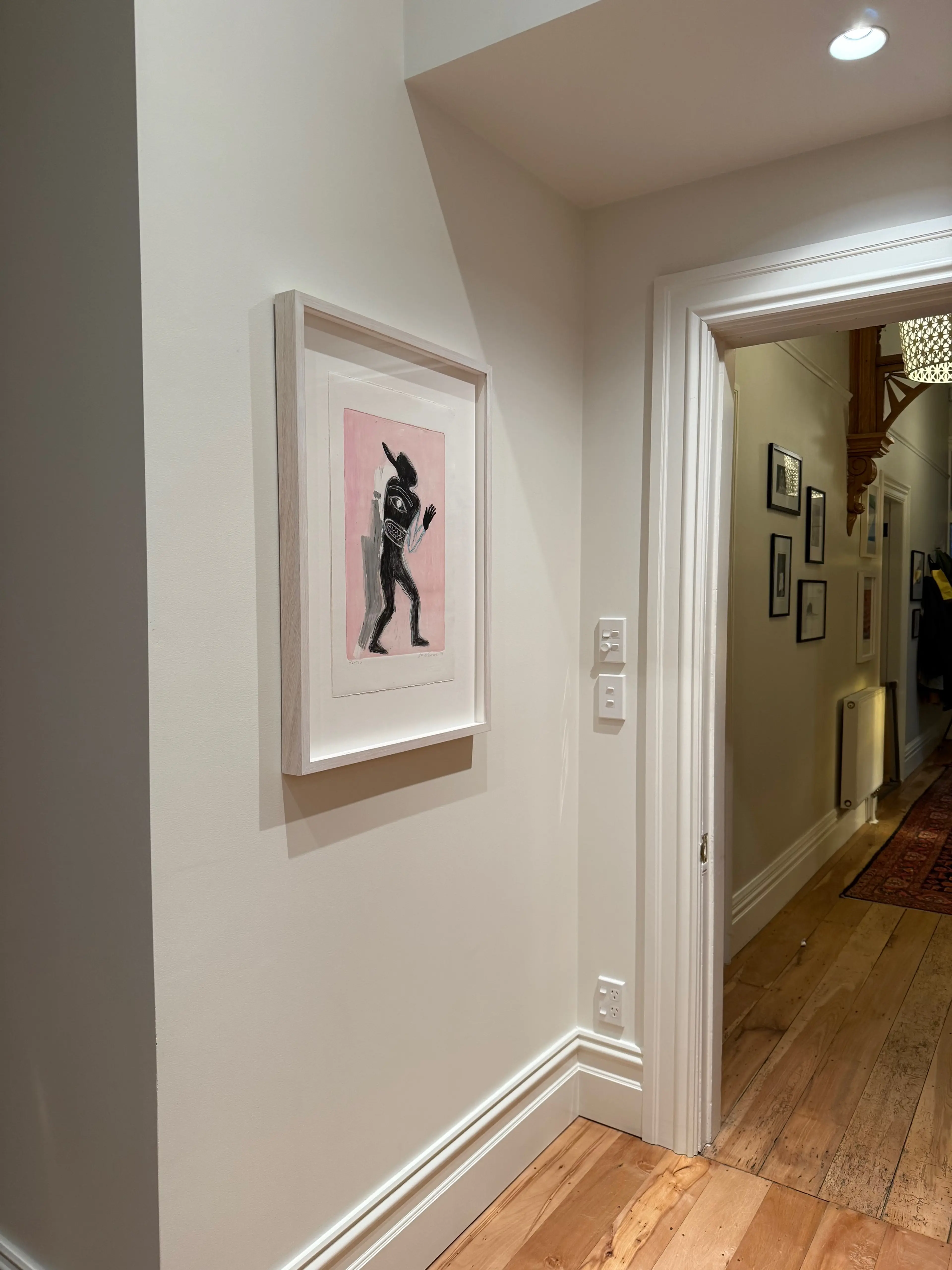Disclaimer: not a word of this was written by ChatGPT. Or any GPT. 100% human, guaranteed.

Our futures lab, our sandbox, our launchpad
Alphero Intelligence is the next evolution of our Ideas Factory. The Ideas Factory was created in 2018 to help us find the next white-space in an increasingly commoditised digital world. We wanted to create an environment and a framework for our team and clients to be safe, be curious, try things, test and learn. More than anything though it was about facilitating a new type of mindset, and expanding the toolbox of things that our team took into every client engagement and in solving problems in creative ways. We took a LOT of what we learned into our client work and even this month are approaching a new product with a technology approach we first piloted in the Ideas Factory.
But time moves on. Pandemics happen. Focus shifts. The white space emerges. And it was time for the Ideas Factory to have a major facelift! Welcome to Alphero Intelligence! More than a futures lab. More than AI. More than technology. It encompasses market and socioeconomic trends, design and creative, strategy, technology and anything else that contributes to the tapestry of our future. Nothing is off the table.
It’s a mindset of how we are asking our team to show up every day. Anchored around our brand pillars: Inventive, Emotive, Brave.
Our principles for Alphero Intelligence Labs include openness, collaboration and sharing. So buckle up for the good, the bad, the interesting, the whacky. We’re putting it out there. What we are exploring. What we are trying. What we are thinking. We have a backlog of 100s of things to explore and much of it will be landing on this site.
A bit more of the why, the what and the how…
One foot in 2025, one in 2030
The pace of change right now is moderately terrifying. Our ways of working in digital are undergoing a radical shift. And with intent-first, screen-optional, composable, intelligent, AI-underpinned capabilities evolving rapidly, we see the impending biggest (r)evolution of future customer experiences since the internet became a thing. But, you can’t just flip a business (or industry) on its head based on crystal balls and educated guesses.
This means as a digital agency we need to have a foot in today, and a foot in the future. We need to be anticipating how digital services might flex, evolve, transform. We need to understand the potential. We need to not just theorise but adapt, learn and apply our skills to not just equip ourselves, but to help our clients with their journeys.
From experience, the lifecycle of digital change programmes tends to be 5 to 10 years depending on sectors, and whether these include re-platforming or just a refresh of digital assets. This means any clients embarking on a transformation programme today, need an experience and architectural framework that will still be sound in 2030, and will enable them to support rapid evolution and adaption of their digital products and services. This is possible!
In other words, even if your organisation is nowhere near ready for the AI / LLM / agent-y woo-woo now, if you are delivering (or considering) a bunch of new digital stuff you really should be thinking about how to design and architect it for later.
Our working motto: Get ready
This is why our catchphrase for Alphero Intelligence is “Get ready”. It’s the mindset we are encouraging in our team, and discussing with our clients. Stay curious, encourage exploration so people don’t just understand the potential of future technology building blocks, but have practical, applied experience in using them. More significantly we are approaching this with a holistic mindset beyond the technology. AI widgets and smart doodads have a bit of a ‘so what’ flavour unless this has clear wrap-arounds and connections with business objectives, user intents, and human and ethical drivers.
After meeting with (another) CDO yesterday who expressed frustration that every vendor he talks to is pushing agents and agentic interfaces, we hear you! With Alphero Intelligence we want to be more intelligent ourselves in how we approach the emerging and the new. At Alphero we have always been about outcomes first, and at the end of the day while we see the writing on the wall for quite a different kind of future, the reality is that it will take time, there will be industries more ripe for early adoption, and some organisations have hard stuff they are sweating today and for the foreseeable future.
Our view is always to have a clear eye on the future. Have a roadmap that brings it to life so people can imagine it and can see what you are eventually shooting for. Design and architect for change, and leave room for what’s next.
The future is mobile — ten themes
One of our big focus areas for the ideas factory is considering how AI might impact future customer experiences for digital. Mobile is a big part of this. Why mobile? First of all we kinda built our brand on mobile right from before it was a thing. At Alphero we have delivered many of the most groundbreaking mobile experiences in New Zealand.
In this context though, we are actually not talking about mobile devices. We are talking about mobile people. The potential for experiences to adapt, transform, and move with the human based on their intent, their context, their location. There may be a phone. There may be sensors, voice, sound, and a whole raft of other types of surfaces.
So a bit of a drum-roll to introduce our 10 themes for the intelligent mobile future. Our themes include technology, but also consider humanistic and ethnical drivers. We want to clearly include the human in our thinking, exploration and solutions. This will be an evolving framework and we fully reserve the right to drop or merge themes, and to add new ones!

These ten themes guide every prototype and project.
1. Intent first - What is the human intention, independent of screens? This is the most important thing to get your head around. It means designing and architecting intent-first. People figure out a goal, and the agent figures out the rest. Screens are optional.

2. Composable - Solutions assemble themselves from a library of reusable components that any app, agent or system can call. A payment capability works equally well in voice, mobile, or IoT contexts.
3. Contextual flow - This is the ‘interfaces’ for intent first, composable components. Where is the user physically, mentally, emotionally when we show up? Interfaces could morph across screens, surfaces, voice and more - based on location, device, time, emotional state, and cognitive load.
4. Hybrid intelligence - You may have heard of edge intelligence (or local AI / intelligence on a device). We are considering how edge intelligence plays nicely with intelligence in the cloud. Edge is hyper-fast, personalised, private, local. . Cloud intelligence handles the heavy lifting through complex reasoning, scheduling, cross-device orchestration, and collaborative insights that require fresh data and massive processing power.
5. Emotional design - existing digital products are already struggling with homogenisation of the user experiences. The risk of future experiences feeling increasingly robotic and less human is high. How do you consider bringing that emotional connection and heart into experiences that morph across screens, surfaces, sensors and agentic interactions. Where is your brand in this?
6. Sensory brand - this is a bit of a subset of emotional design but is explicitly focused on interactions with anything other than a screen. How can you bring other sensory elements into play and have an experience feel like your brand. Consider sound, voice, haptics, light. Even smell.
7. Inclusive & augmented - Will an “intent-first, context-aware, edge-smart” future include more people or widen the gap? It can widen the circle … if we design it right. With the separation of intents and skills from screens, and augmentation of interfaces, we have the ability to compose personalised experiences that include wider audiences.
8. Explainable & ethical - If we had to sit beside the user and justify every automated action, could we? That means: clear “why” and “what we used” for each decision, explicit consent before new data use, an easy undo, smallest data kept private by default, and regular bias/safety checks.
9. Sustainable - How can we give value while costing the planet less? Do more with less: lean models, reused capabilities, minimal data/network use. Schedule heavy work when charging or the grid is green, support older devices, track carbon/battery budgets.
10. Trust & security - There’s a reason our diagram wraps trust and security around everything. It’s because trust and security are woven through every other theme. It’s fair to say that the more technology-focused themes from 1-4 skew towards security. Consider access control, identity verification, data protection, privacy and much more. But to build trust you need human and ethical themes woven through every experience and every solution.
Intent before technology
The most significant thing here is radically rethinking how we design and architect new services to be intent first, and screen optional. On day one, there may be a load of screens but ideally we structure this so whatever we do is composable, and future experiences can substitute today’s screens for agentic experiences or adapt for a range of surfaces, sensors and the devices of tomorrow. (Thinking of you Jony Ives and Sam Altman).
This doesn’t mean that in our Alphero Intelligence Labs we aren’t exploring a LOT of technologies. But these are tools, and ideally if we know what’s good, what works, they become solid enablers to drop into future solutions.
Trust and security, wrapped-around
Trust and security is a massive consideration. At the end of the day a lot of the security side is anchored around the technology parts (access control, identity management, data protection and privacy and all the other things). But building the trust side with the human requires the wraparound consideration of humanistic and ethical drivers. We will be doing a lot of experimentation here, not least of which is exploring new ways to verify a user’s identity once screens become optional. Thanks to ChatGPT for suggesting a user’s ‘scent’ footprint. It’s hard to get out of my head. And we do have a concept image of a user boarding a plane by walking past a scent sensor. (WTH).
And… what about inclusion
Inclusion has been a particularly interesting topic area that we are exploring. I’ve had a few conversations recently with a client from Health, and with Amanda C (from our Auckland team) about her recent trip back to the USA. There is a real risk that the ‘digital divide’ just gets wider here. As we double down on technology, what does this mean for those who can’t afford it, can’t use it, don’t trust it? Here’s another lens: what if the future brings the potential to create more inclusive services? Right now many digital experiences pay lip-service to inclusion with a focus on accessibility that’s often limited to the vision impaired relying on screen-readers to follow a workflow designed
How about this for a lens? If we create intent-first, adaptive, intelligent experiences that compose and compile independently of screens and based on your context - this means future experiences can dynamically adapt not just based on location and other variables, but also on your own preferences and needs. Imagine if rather than limping through a digital experience with screen-readers and disabled motion-design, a voice and sensory-first experience adapts around you.
What does all this mean for our clients?
At the end of the day our reason for being at Alphero is to support our clients. To help you to achieve the business and customer outcomes you are looking for. We have an obligation to make sure that we are ready for the future, and that the digital services, products and experiences we create and deliver (with you) are future-forward and will stand the test of time. When the future starts looking all up in the air, that sort of thinking is particularly critical.
We see our Alphero Intelligence Labs as more than an internal R&D or innovation hub. This is a framework and an approach that we can do with you. We are already bringing our learnings, mindsets and skills into projects today. We are already collaborating with some clients on Alphero Intelligence initiatives. We are already bringing the future to life in our strategy engagements, or to support framing up future roadmaps. It is a mindset shift and we know from our own team that sometimes it takes a catalyst.
At the end of the day, our journey is your journey and we’d love for you to be part of it
So, join the experiment!
And come with us! Tell us what’s on your mind, bring us your toughest “what if…?” It can be about anything from helping you to wrap your head around what the future customer experience might look like, to running futures workshops to inspire your teams in off-sites, collaborative R&D, prototyping, ideating, concepting, exploring, researching, exploration of tools, technologies and processes. Future experiences, to future ways of working. Or how to help your teams with the mindset shifts that will likely to be required for approaching new ways of delivery, and producing the intelligent experiences of the future.
We’d love to hear from you. Drop us a line.

